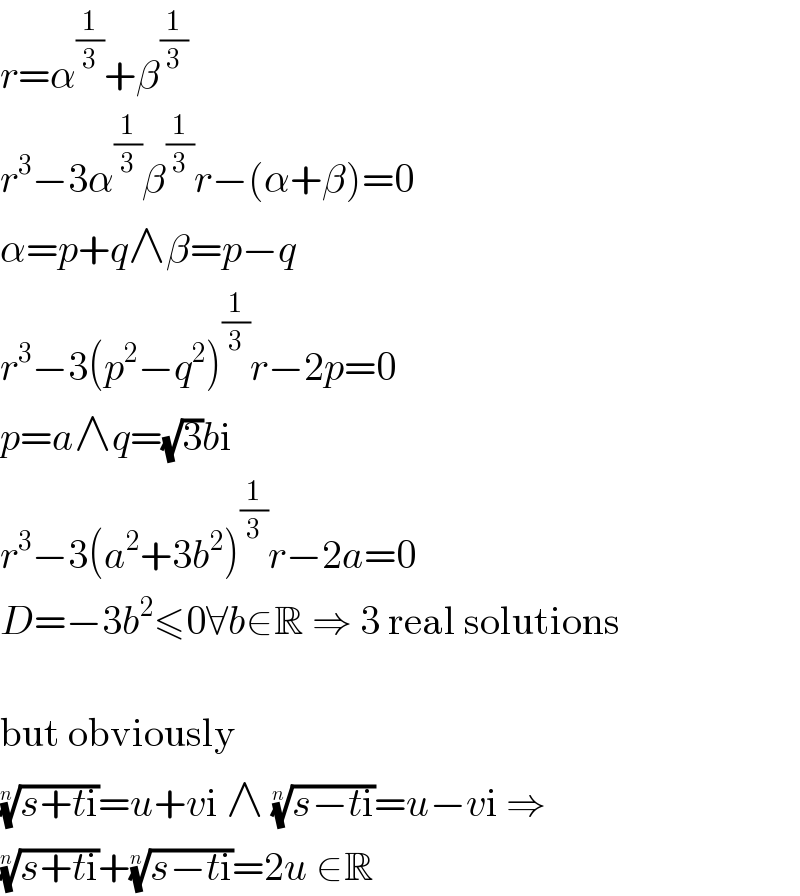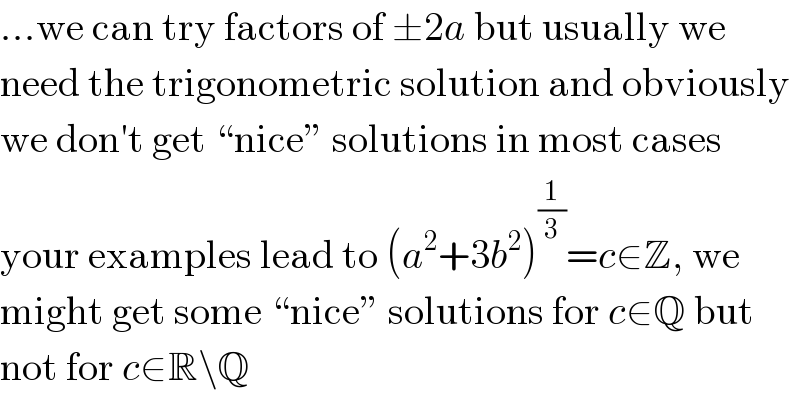
Question Number 78857 by mr W last updated on 21/Jan/20

$${with}\:{a},{b}\in{R}\:{prove}\:{that} \\ $$$$\sqrt[{\mathrm{3}}]{{a}+\sqrt{\mathrm{3}}{bi}}+\sqrt[{\mathrm{3}}]{{a}−\sqrt{\mathrm{3}}{bi}} \\ $$$${has}\:{always}\:{real}\:{value}\:{and}\:{find}\:{this} \\ $$$${value}\:\left({or}\:{a}\:{way}\:{how}\:{to}\:{find}\right). \\ $$$${examples}: \\ $$$${a}=\mathrm{15},\:{b}=\frac{\mathrm{28}}{\mathrm{9}}\:\:\Rightarrow\:{result}=\mathrm{5} \\ $$$${a}=\mathrm{6},\:{b}=\frac{\mathrm{35}}{\mathrm{9}}\:\:\Rightarrow\:{result}=\mathrm{4} \\ $$$${a}=−\mathrm{24},\:{b}=\frac{\mathrm{80}}{\mathrm{9}}\:\:\Rightarrow\:{result}=\mathrm{4} \\ $$
Commented by mr W last updated on 21/Jan/20

$${i}'{m}\:{not}\:{sure}\:{if}\:{the}\:{statement}\:{is}\:{correct}. \\ $$$${discussion}\:{is}\:{welcome}! \\ $$
Commented by john santu last updated on 22/Jan/20

$${let}\:{u}=\:\sqrt[{\mathrm{3}}]{{a}+{bi}\sqrt{\mathrm{3}}\:}\:\Rightarrow{u}^{\mathrm{3}} ={a}+{bi}\sqrt{\mathrm{3}} \\ $$$${v}\:=\sqrt[{\mathrm{3}}]{{a}−{bi}\sqrt{\mathrm{3}}}\:\Rightarrow{v}^{\mathrm{3}} ={a}−{bi}\sqrt{\mathrm{3}} \\ $$$${u}+{v}\:=\:\frac{{u}^{\mathrm{3}} +{v}^{\mathrm{3}} }{{u}^{\mathrm{2}} −{uv}+{v}^{\mathrm{2}} } \\ $$$${u}^{\mathrm{3}} +{v}^{\mathrm{3}} \:=\:\mathrm{2}{a}\: \\ $$$${u}^{\mathrm{2}} −{uv}+{v}^{\mathrm{2}} =\:\sqrt[{\mathrm{3}}]{{a}^{\mathrm{2}} −\mathrm{3}{b}^{\mathrm{2}} +\mathrm{2}{abi}\sqrt{\mathrm{3}}}\:− \\ $$$$\sqrt[{\mathrm{3}}]{{a}^{\mathrm{2}} +\mathrm{3}{b}^{\mathrm{2}} }\:+\sqrt[{\mathrm{3}}]{{a}^{\mathrm{2}} +\mathrm{3}{b}^{\mathrm{2}} −\mathrm{2}{abi}\sqrt{\mathrm{3}}} \\ $$
Commented by john santu last updated on 21/Jan/20

$${difficult}\:{to}\:{write}\:{sir}.\:{too}\:{long} \\ $$
Commented by mr W last updated on 21/Jan/20

$${thanks}.\:{but}\:{not}\:{yet}\:{understood}\:{what}\: \\ $$$${you}\:{mean}. \\ $$
Commented by john santu last updated on 21/Jan/20

$${wait}\:{sir} \\ $$
Answered by MJS last updated on 21/Jan/20

$${r}=\alpha^{\frac{\mathrm{1}}{\mathrm{3}}} +\beta^{\frac{\mathrm{1}}{\mathrm{3}}} \\ $$$${r}^{\mathrm{3}} −\mathrm{3}\alpha^{\frac{\mathrm{1}}{\mathrm{3}}} \beta^{\frac{\mathrm{1}}{\mathrm{3}}} {r}−\left(\alpha+\beta\right)=\mathrm{0} \\ $$$$\alpha={p}+{q}\wedge\beta={p}−{q} \\ $$$${r}^{\mathrm{3}} −\mathrm{3}\left({p}^{\mathrm{2}} −{q}^{\mathrm{2}} \right)^{\frac{\mathrm{1}}{\mathrm{3}}} {r}−\mathrm{2}{p}=\mathrm{0} \\ $$$${p}={a}\wedge{q}=\sqrt{\mathrm{3}}{b}\mathrm{i} \\ $$$${r}^{\mathrm{3}} −\mathrm{3}\left({a}^{\mathrm{2}} +\mathrm{3}{b}^{\mathrm{2}} \right)^{\frac{\mathrm{1}}{\mathrm{3}}} {r}−\mathrm{2}{a}=\mathrm{0} \\ $$$${D}=−\mathrm{3}{b}^{\mathrm{2}} \leqslant\mathrm{0}\forall{b}\in\mathbb{R}\:\Rightarrow\:\mathrm{3}\:\mathrm{real}\:\mathrm{solutions} \\ $$$$ \\ $$$$\mathrm{but}\:\mathrm{obviously} \\ $$$$\sqrt[{{n}}]{{s}+{t}\mathrm{i}}={u}+{v}\mathrm{i}\:\wedge\:\sqrt[{{n}}]{{s}−{t}\mathrm{i}}={u}−{v}\mathrm{i}\:\Rightarrow \\ $$$$\sqrt[{{n}}]{{s}+{t}\mathrm{i}}+\sqrt[{{n}}]{{s}−{t}\mathrm{i}}=\mathrm{2}{u}\:\in\mathbb{R} \\ $$
Commented by MJS last updated on 21/Jan/20

$$...\mathrm{we}\:\mathrm{can}\:\mathrm{try}\:\mathrm{factors}\:\mathrm{of}\:\pm\mathrm{2}{a}\:\mathrm{but}\:\mathrm{usually}\:\mathrm{we} \\ $$$$\mathrm{need}\:\mathrm{the}\:\mathrm{trigonometric}\:\mathrm{solution}\:\mathrm{and}\:\mathrm{obviously} \\ $$$$\mathrm{we}\:\mathrm{don}'\mathrm{t}\:\mathrm{get}\:``\mathrm{nice}''\:\mathrm{solutions}\:\mathrm{in}\:\mathrm{most}\:\mathrm{cases} \\ $$$$\mathrm{your}\:\mathrm{examples}\:\mathrm{lead}\:\mathrm{to}\:\left({a}^{\mathrm{2}} +\mathrm{3}{b}^{\mathrm{2}} \right)^{\frac{\mathrm{1}}{\mathrm{3}}} ={c}\in\mathbb{Z},\:\mathrm{we} \\ $$$$\mathrm{might}\:\mathrm{get}\:\mathrm{some}\:``\mathrm{nice}''\:\mathrm{solutions}\:\mathrm{for}\:{c}\in\mathbb{Q}\:\mathrm{but} \\ $$$$\mathrm{not}\:\mathrm{for}\:{c}\in\mathbb{R}\backslash\mathbb{Q} \\ $$
Commented by mr W last updated on 21/Jan/20

$${thank}\:{you}\:{sir}!\:{very}\:{informative}\:{answer}! \\ $$
